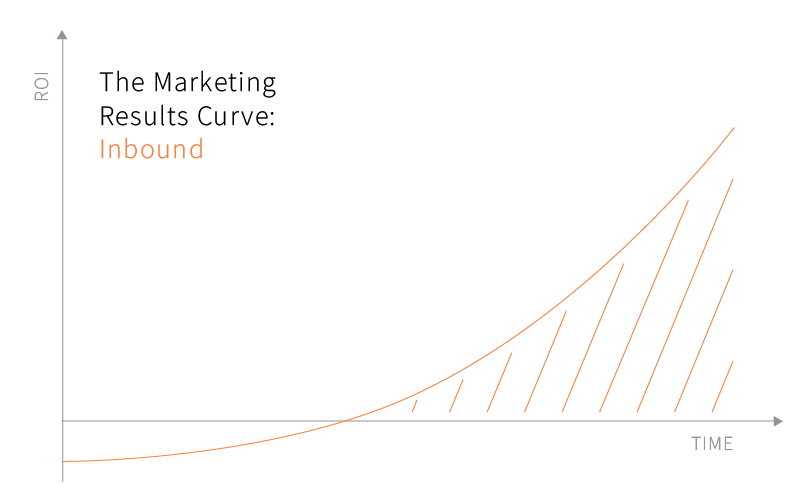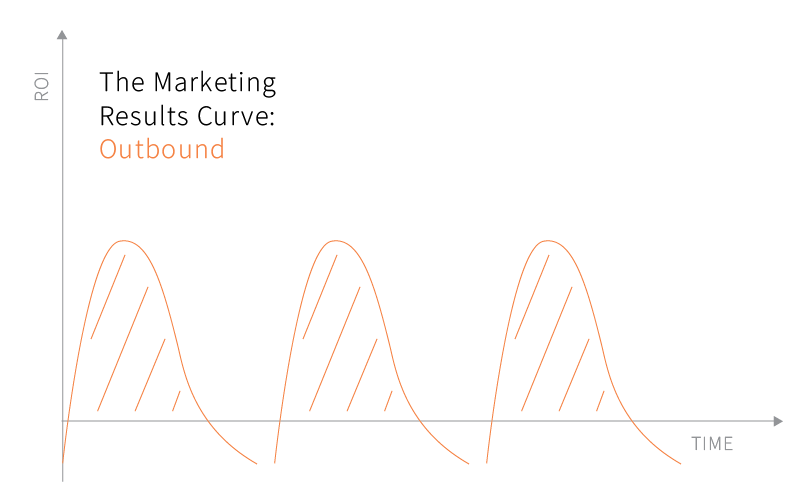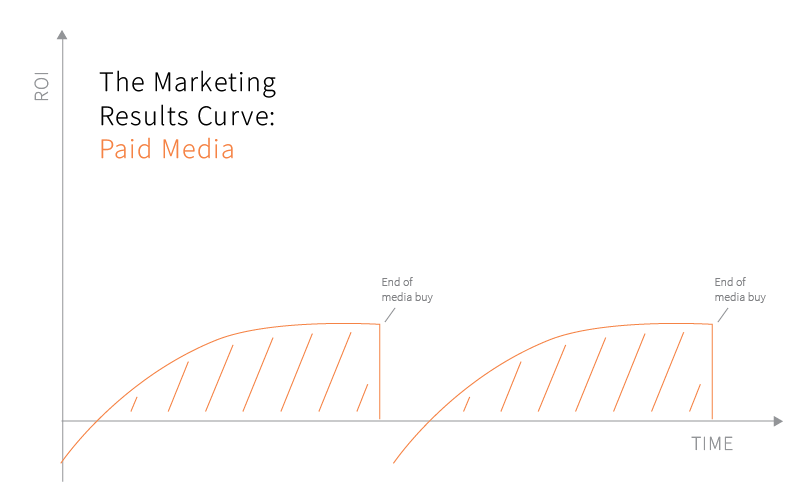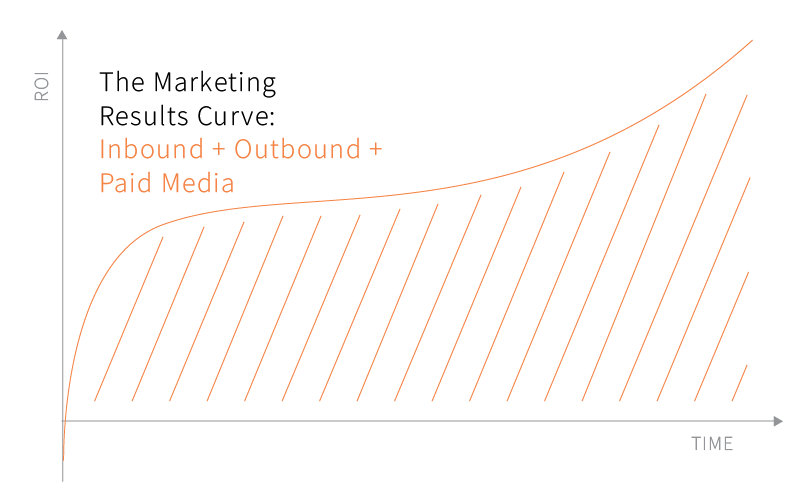 Are you playing the short game or the long game? In other words, what’s more important to you – fast results or sustainable success from your marketing program?
Are you playing the short game or the long game? In other words, what’s more important to you – fast results or sustainable success from your marketing program?
It’s not a trick question and there’s not a wrong answer either. But unless you’re prepared to make a significant investment in marketing, you’ll probably have to make a choice (and of course, most choices come with tradeoffs).
This graph is what we call The Marketing Results Curve. On the X axis, you have time. On the Y-axis, you have ROI.

As time passes (and we move from left to right on this graph), we also want to move North toward results as quickly as possible. But for your organization, how quickly is quickly enough?
Three paths to results:
From my viewpoint, there are three ways to get to marketing results:
- Inbound
- Outbound
- Paid Media
Each path warrants a look in your marketing mix. But each should also come with different expectations for results – both in terms of velocity and ceiling. Let’s take a closer look and use some visuals to illustrate.
Inbound Marketing
Inbound focuses on building an authoritative presence online. Ideally, here’s how it works:
- You develop thought-leadership content that establishes credibility for your website with the search engines.
- That credibility drives up your search rankings, which leads to better visibility in Google searches.
- Increased visibility drives more website traffic from individuals who are looking for answers to questions you can address and solutions to problems you can solve.
- More (and better) website traffic thickens your sales pipeline with qualified leads.
When done well, inbound is the long game – the sustainable solution. The downside is that in most scenarios, a significant investment of time, money or both is required to establish that necessary authority online. (Note that real-world authority doesn’t automatically translate into online authority). So unless you’re cheating – which Google doesn’t like – results can take months or more to materialize. And even then, it can be a slow climb. Here’s what the inbound results curve usually looks like if you’re starting from scratch:

The payoff with inbound comes once you’ve established an authoritative position with Google, Bing, etc, and results begin to snowball. When that curve starts turning upward, you can often dial back your investment and keep seeing results pour in. But you have to earn that authority by solidifying your role online as a top-tier resource in your space. We’ve seen it happen for many of our clients who have committed to the long game. But not for those who call it quits after six or twelve months.
Outbound Marketing
With outbound marketing, on the other hand, you focus on an ideal customer profile (both the type of company and types of people at those companies whose attention and trust you need to earn), build a list of targets and go after each directly. We often refer to this approach as account-based marketing.
The benefit of outbound is that results can materialize very quickly, assuming there’s market share to be won. Unlike inbound, where you’re slowly building a sustainable lead-generation machine, with outbound, you’re either buying or quickly building a list of target prospects. In theory, you could be booking phone calls with future customers tomorrow.
But once you’ve burned through your list, you’re back to square one, spending more time or money to build and pursue a fresh list of targets.

When done effectively, outbound is a great way to get wins quickly. But it’s not a self-sustaining machine. Instead, you’ll always be feeding the beast with your time and money.
Paid Media
Paid media (which I want to discuss as its own entity here, even though you could technically stick it under the umbrella of outbound marketing) is about buying visibility in front of a defined audience. As Joe Pulizzi describes in his exceptional book Killing Marketing, paying for advertising is like renting access to your audience for a limited period of time, from a big media company.
Think of online paid media for B2B companies as the equivalent of a consumer brand buying ad space on a billboard or running a tv spot. You rent a slot in exchange for a fee. And when your time or budget expires, so goes your visibility. Similar to outbound methodology (like with account-based marketing), paid media can drive a short-term spike. But long-term viability requires plugging the machine with more coins when your media buy ends or your balance has gone to zero.

So which will it be?
There’s no canned answer to whether you choose fast results or sustainable success. Marketing is complex and a number of factors can (and should) influence your decision:
Here are some external factors to consider:
- Are you in a competitive, crowded marketplace?
- Are you a giant or a less-known player there?
- Does Google respect you yet?
- Or are you nowhere to be found for relevant searches?
And then there are the internal factors:
- Is your sales cycle short or long? (Will a new lead take months or longer to turn into revenue?)
- Do you have a board of advisors or panel of investors breathing down your neck about getting results yesterday?
- Do you have internal personnel (with both capacity to fill and the right skill sets) to strategize and implement an effective marketing plan? Or will you have to hire outside consultants or an agency?
- Oh, and what’s your budget?
If you have the luxury of time at your disposal and are willing to be patient, inbound (done well) is likely to be your answer. But if you need results to materialize quickly, then you’re best off turning to outbound and paid media.
Does it have to be one or the other?
Not necessarily.
If your budget allows for a sufficient investment in both the long game and the short game, I recommend creating a balance. Now you open up the possibility of your results curve looking more like this:

The beauty here, though it comes with a higher price tag, is that you play the long game, building that sustainable lead-generation machine. But you also fill the short-term void in that results curve with strategies and tactics that generate quick wins. The risk here is that you spread your budget too thin and accomplish nothing. So if you go this route, be prepared to invest sufficiently in both categories.
Whichever path you choose, be clear with yourself and team about expectations, and understand where the tradeoffs lie.
If you’re interested in talking about which approach to take for your business, please consider requesting a consultation.